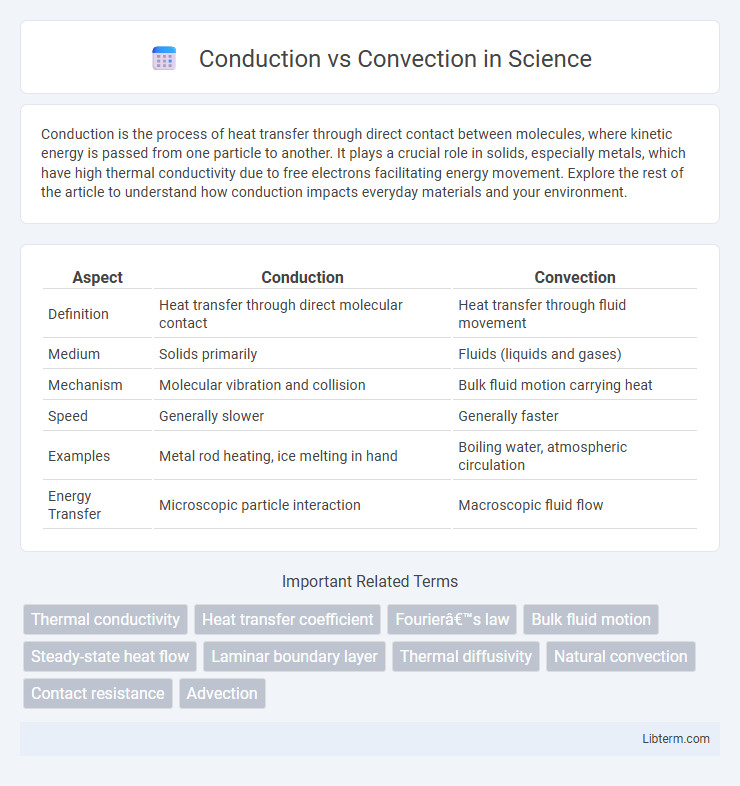Conduction is the process of heat transfer through direct contact between molecules, where kinetic energy is passed from one particle to another. It plays a crucial role in solids, especially metals, which have high thermal conductivity due to free electrons facilitating energy movement. Explore the rest of the article to understand how conduction impacts everyday materials and your environment.
Table of Comparison
| Aspect | Conduction | Convection |
|---|---|---|
| Definition | Heat transfer through direct molecular contact | Heat transfer through fluid movement |
| Medium | Solids primarily | Fluids (liquids and gases) |
| Mechanism | Molecular vibration and collision | Bulk fluid motion carrying heat |
| Speed | Generally slower | Generally faster |
| Examples | Metal rod heating, ice melting in hand | Boiling water, atmospheric circulation |
| Energy Transfer | Microscopic particle interaction | Macroscopic fluid flow |
Introduction to Heat Transfer
Heat transfer occurs through conduction and convection, two fundamental modes involving the movement of thermal energy. Conduction transfers heat through direct molecular collisions within a solid or between solids in contact, governed by Fourier's law. Convection involves heat transfer through fluid motion, combining conduction and fluid dynamics, described by Newton's law of cooling.
Defining Conduction
Conduction is the transfer of heat through direct molecular collision within a solid or between solids in contact, without the movement of the material as a whole. It relies on thermal conductivity, where energy passes from higher to lower temperature regions through vibration and electron movement. Metals, such as copper and aluminum, exhibit high conduction rates due to free electron flow facilitating efficient heat transfer.
Defining Convection
Convection is the heat transfer process involving the movement of fluid--liquids or gases--caused by temperature-induced density differences, resulting in a bulk fluid motion that carries thermal energy. Unlike conduction, which transfers heat through direct molecular contact in solids, convection relies on the physical movement of fluid masses to transport heat. This mechanism plays a crucial role in atmospheric phenomena, ocean currents, and heating systems by efficiently redistributing thermal energy.
Key Differences Between Conduction and Convection
Conduction transfers heat through direct molecular contact within solids, relying on collisions and vibrations between particles without fluid movement. Convection involves heat transfer via the bulk movement of fluids such as liquids and gases, where warmer, less dense regions rise and cooler, denser areas sink, creating convection currents. Key differences include conduction's dependence on solid materials and localized energy transfer, while convection requires fluid movement and facilitates larger-scale heat distribution.
Mechanisms of Conduction
Conduction is the transfer of heat through direct molecular collisions within a solid or between solids in contact, where kinetic energy is passed from high-energy particles to adjacent lower-energy particles. This mechanism relies on the vibration and interaction of atoms or free electrons in conductive materials, facilitating efficient thermal energy flow without mass movement. Metals exhibit high conduction rates due to free electrons acting as heat carriers, while insulators conduct heat more slowly through atomic vibrations.
Mechanisms of Convection
Convection involves the transfer of heat through the movement of fluid masses, primarily driven by density differences caused by temperature variations within the fluid. Warm fluid rises due to lower density, while cooler, denser fluid sinks, creating a continuous circulation pattern known as a convection current. This mechanism efficiently transfers heat in liquids and gases, contrasting with conduction, which relies on direct molecular interactions without fluid movement.
Real-World Examples of Conduction
Conduction transfers heat through direct molecular contact, evident in real-world examples like a metal spoon heating in a hot pot or the warmth felt when touching a heated stovetop burner. This process is dominant in solids where particles are tightly packed, enabling efficient energy transfer from the hot end to the cooler end. Understanding conduction is crucial for designing cookware materials and improving thermal insulation in building structures.
Real-World Examples of Convection
Convection plays a vital role in everyday phenomena such as the heating of water in a pot, where warm water rises and cool water descends, creating a circulation pattern. Atmospheric convection drives weather patterns, including thunderstorms and sea breezes, by transporting heat through air movement. In building ventilation systems, convection facilitates efficient heat distribution, maintaining indoor comfort by moving warm or cool air throughout spaces.
Factors Affecting Heat Transfer
Heat transfer during conduction depends on material thermal conductivity, cross-sectional area, temperature gradient, and thickness of the medium. Convection heat transfer is influenced by fluid properties such as viscosity, density, specific heat, fluid velocity, and temperature difference between the surface and fluid. Surface roughness and flow regime--laminar or turbulent--also significantly affect convective heat transfer rates.
Applications in Industry and Everyday Life
Conduction transfers heat through direct contact, making it ideal for applications like cooking utensils and metal forging where precise heat control is needed. Convection relies on fluid or air movement to distribute heat, underpinning systems such as HVAC, industrial cooling, and weather pattern management. Both conduction and convection are essential in industries like manufacturing and energy production for efficient thermal management.
Conduction Infographic

 libterm.com
libterm.com